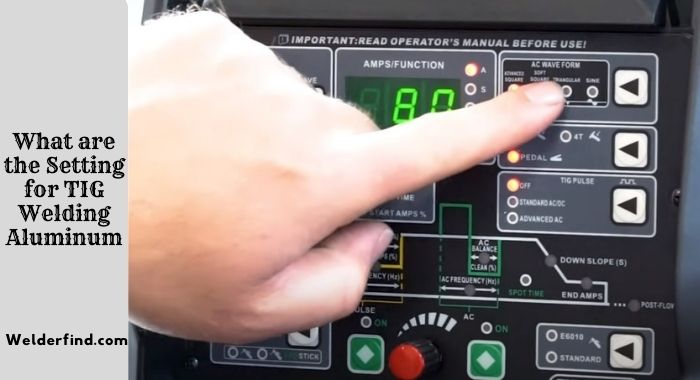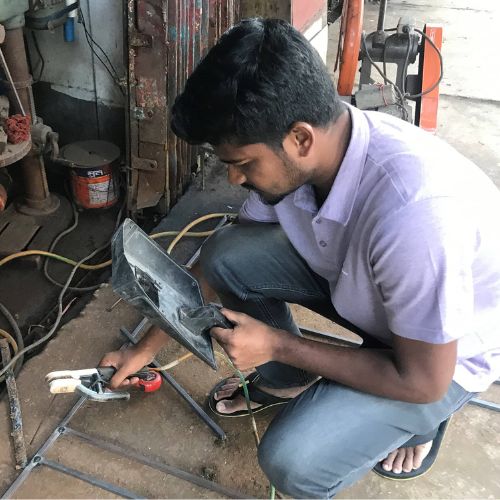Tig welding has recently become very popular among DIYers and professionals because it allows joining any kind of metal together. You can even join any thickness of aluminum using the Tig welding process. In addition, this welding is neat, no additional smoke generated and very few welding defects due to this welding process.
So, it’s important for any of us to know this new welding system and how to tig welding for beginners. Here I am a tig welding expert and will guide you on how to do this welding and how to minimize the mistakes.
Let’s dig into the content
What are the Setting for TIG Welding Aluminum?
The new guys who have never done aluminum welding don’t know welding generates oxide layers. The oxidation in aluminum is dull silver color and tough to see red oxidation that we normally see during steel welding.

Also, the melting temperature of aluminum is three times higher than the base material. So there must be some pre-welding setting of the machine for aluminum Tig welding.
Balance Control
When you start welding at AC polarity, there is always an electrode negative cycle (EN) and an electrode positive cycle (EP). EN is considered the welding side of AC waveform, and EP indicates the removal of oxide. So if you use modern welding equipment, it allows you to adjust the puddle you see during welding.
The older welding devices always had a balance ratio of 50:50 for EN and EP. But the latest GTAW (Tig Welder) has a factory preset balance of 75% for EN and 25% for EP.
If a small black puddle appears during welding, it means “peppering” is happening. To control it, decrease the EN and increase the EP. It helps to remove oxide during aluminum welding.
AC Output Frequency Setting
The output frequency refers to how many times the power source switches polarity per second. The modern GTAW equipment has a 120 Hz output frequency, but the older GTAW used to have a 60 Hz output frequency.
Here, output frequency needs to be higher because it keeps the arc stable so welding onto narrow and tight spaces becomes easier. So keep the output frequency 150 to 250 Hz on aluminum, it ensures an accurate welding area and prevents heating up a large area.
How to TIG Welding Aluminum
Tig welding on aluminum is nothing intimidating, you can do it even with a little bit of practice. Here, I’ll let you know the proper steps of Tig welding and Tig welding skills.
Puddle Control
Armature Tig welders don’t have stable basic hand and control at the very beginning on aluminum. That’s why aluminum acts like a big heat sink and continues transferring heat away from a wide area, creating puddles.
So first thing first, you must know how to control puddle generation. For that, hand and torch placement is the key. So you must be good at hand and torch placement; otherwise, you’ll waste a lot of aluminum.
- First, hold the torch by the base of your hand and keep it flat against the table.
- Now, keep the torch moving forward with a steady motion. Keep the torch 5 to 15 degrees.
- Keep the tungsten close to the workpiece otherwise, the arc spreads out too wide and creates an overheating problem, which will result in loss of puddle control.
Filler Metal Deposition
Now keep continuing to give light pressure on the hand and keep a firm grip on the welding torch. You must hold the torch and the filler metal at 90 degrees configuration to each other. So keep in mind that you shouldn’t drag the torch; always push it and use the filler metal on the leading edge of the puddle.
Most of the time, beginner welders try to dab the filler metal and dip the tungsten into filler metal that contaminates the tungsten.
Common Mistakes in Tig Welding Aluminum & How to avoid Them
Welding is not that tough work once you are used to it, but welding aluminum for the first time may look complex if you are an expert in welding other metals.
There are some regular mistakes that may lead to some serious mistakes. So let’s know about the common mistakes we do
- Right polarity setting is very important. The arc doesn’t break through the oxide layer without the right polarity.
- Don’t reduce the arc length; it may cause improper welding on aluminum.
- Always wear safety equipment like safety goggles, long sleeve shirts and pants, leather boots and gloves during welding.
- The poor gas connection will lead to bad welding. You must ensure the right gas and no loose fitting.
- Don’t increase the amperage; it could lead to material burn through.
Advantages & Disadvantages Of Tig Welding Aluminum
Advantage
- It uses non-consumable tungsten.
- You can add filler metal by hand.
- High quality and clean welding.
- This welding can weld more metals
Disadvantage
- Time consuming setup process.
- Lack of penetration power for thick metals
Last Words
Welding aluminum is a challenging task but very much rewarding. Using the right tools and skills, you can have perfect results. So, always try to use an AC/DC Tig welder for the best results for welding aluminum.
Don’t try to experiment with changing the basic parameters; use 1 amp for every inch of metal thickness. Hopefully, from now on, welding on aluminum will be fun for you.
